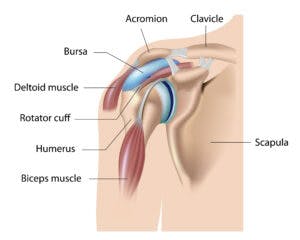Do you have shoulder pain when reaching with an outstretched arm or lifting overhead? Shoulder impingement involves compression of your rotator cuff tendons between the top of your shoulder blade and upper arm bone. Other structures involved include your biceps tendon and bursa (a fluid-filled sac between 2 bones). Shoulder impingement accounts for approximately 1/3 of all shoulder pain.

During normal activities of daily living, your rotator cuff becomes compressed and stretched. This typically does not result in any pain. However, several factors contribute to excessive compression and pain.
Thankfully, the majority of these factors are modifiable through exercise. Research shows exercise is at least equally effective or better than medications, injections, and surgery.
Exercise Proven to Help Many Types of Shoulder Pain
Exercise addresses many of the modifiable risk factors that contribute to shoulder impingement. Stretching increases the available space between your shoulder blades and upper arm. This alleviates compression of your rotator cuff, bursa, and biceps tendon.
Strengthening exercises that target your rotator cuff and shoulder blade muscles also increase the available space. Exercising with an appropriate load strengthens the tendons, which further reduces pain. There is no one-size-fits-all exercise approach for shoulder impingement. The following exercises are some examples that may be included in an individualized rehab program.
Easy Stretching Exercises for Shoulder Impingement
Stretching your shoulder is an important part of any shoulder rehab program. In particular, exercises targeting the mobility of your pectoralis minor muscle, thoracic spine, and posterior shoulder are important.
Increasing the length of your pectoralis minor pulls your shoulder blade back. This improves posture and increases the available space for your rotator cuff. Improving extension of your thoracic spine improves posture and overhead shoulder mobility. Stretching the back of your shoulder creates greater space for any compressed soft tissues. To get the best results, perform stretching exercises daily.
Top Rotator Cuff Exercises for Shoulder Impingement
The primary job of your rotator cuff is to center the ball of your arm bone (humerus) in the socket of your shoulder blade. Weakness of your rotator cuff causes the ball to migrate upwards into the bone above it, leading to impingement. Once your shoulder becomes painful, your rotator cuff muscles shut down, leading to a vicious cycle of pain and weakness.
Your rotator cuff must be strengthened to restore proper shoulder function. There are 4 muscles of the rotator cuff. They are the supraspinatus, infraspinatus, teres minor, and subscapularis. These muscles function together and are all strengthened during rehabilitation.
Strengthening exercises are performed 3-4 times per week. Start with a weight that allows you to perform 12 to 15 repetitions for 3 sets. Over several weeks, progress the weight to allow 8 to 10 repetitions for each set. A sense of fatigue and some pain is acceptable and, in most cases, beneficial for recovery. On a 0 to 10 scale, keep the pain levels at 5/10 or less.
Simple Shoulder Blade Exercises for Impingement
Your trapezius and serratus anterior muscles rotate your shoulder blade upwards. They also tilt your shoulder blade backward as you raise your arm. This is essential for overhead function. If your shoulder blade does not appropriately tilt backward or rotate upwards, your arm bone will jam into the bone above it. This results in impingement of your rotator cuff. Follow the guidelines described above for rotator cuff strengthening exercises (i.e., sets, repetitions, etc).
Get Help From Your Physical Therapist
Shoulder impingement is common in athletes, weekend warriors, and sedentary adults. Exercise is the first line of treatment and in most cases, very successful. Your shoulder complex is composed of several joints and many intricate muscles. Therefore, recovery is often slow at first. However, if you stick to your exercise program, expect a full recovery in 3 to 4 months.
For faster results, it is best to work with your physical therapist so your exercise program is targeted to your individual needs. Also, combining exercise and manual therapy speeds up your recovery. Call and schedule an appointment if you would like help from the doctors of physical therapy at BSR.


